Exe-4C and 4D Refraction of light ICSE Class-10 Concise Selina Solutions Chapter-4. We Provide Step by Step Answer of Exercise-4(A), MCQs-4(A), Numericals-4(A), Exercise-4(B), MCQ-4(B), Numericals -4(B), Exercise-4(C), MCQ-4(C),Numericals -4(C), Exercise-4(D) and MCQ-4(D),Questions of Exercise-4 Refraction of light at Plane surfaces ICSE Class-10 . Visit official Website CISCE for detail information about ICSE Board Class-10.
| Board | ICSE |
| Publications | Selina Publication |
| Subject | Physics |
| Class | 10th |
| Chapter-4 | Refraction of light at Plane Surface (Exe-4C and 4D) |
| Book Name | Concise |
| Topics | Solution of Exe-4(A), MCQs, Numericals, Exe-4(B), MCQs, Numericals, , Exe-4(C), MCQs, Numericals, Exe-4(D) and MCQs |
| Academic Session | 2021-2022 |
Refraction of light ICSE Class-10 Concise Physics Solutions Selina Publishers Chapter-4
-: Select Topics :-
Exe-4(A), MCQs, Numericals, Exe-4(B), MCQs, Numericals,
Exe-4(C), MCQs, Numericals, Exe-4(D) and MCQs
Exercise – 4(C) Selina Solutions ICSE Class-10 Refraction of Light at Plane Surfaces
Refraction of light ICSE Class-10 Concise Physics Solutions Selina Publishers Chapter-4
Page 91
Question 1
How is the refractive index of a medium related to the real and apparent depths of an object in that medium?
Answer 1
Relation of refractive index![]() with real and apparent depths
with real and apparent depths
![]()
Question 2
Prove that
Refractive index = ![]()
Answer 2
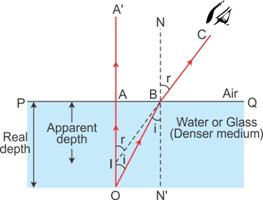
Consider a ray of light incident normally along OA. It passes straight along OAA’. Consider another ray from O (the object) incident at an angle i along OB. This ray gets refracted and passes along BC. On producing this ray BC backwards, it appears to come from the point I, and hence, AI represents the apparent depth, which is less than the real depth AO.
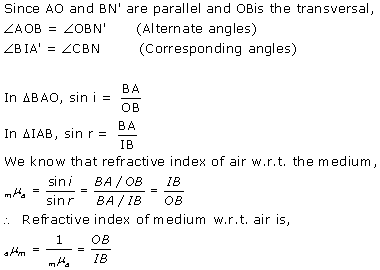
Since the point B is very close to point A, i.e. the object is viewed from a point vertically above the object,

Question 3 (Exe-4C and 4D Refraction of light)
A tank of water is viewed normally from above.
(a) State how the depth of tank appears to change.
(b) Draw a labelled ray diagram to explain your answer.
Answer 3
The depth of the tank appears to be lesser than its real depth. This happens due to the refraction of light from a denser medium (water) to a rarer medium.
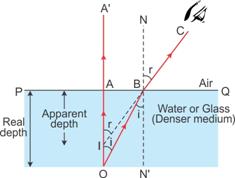
Question 4
Water in a pond appears to be only three-quarters of its actual depth. (a) What property of light is responsible for this observation? Illustrate your answer with the help of a ray diagram. (b) How is the refractive index of water calculated from its real and apparent depths?
Answer 4
‘Refraction of light’ is responsible for this property.
When light coming from denser medium enters rarer medium, it is bent away from the normal.
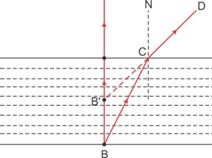
Let any object B is at the bottom of a pond. Consider a light ray BC from the object that moves from water to air. After refraction from the water surface, the ray moves away from the normal N along the path CD. The produce of CD appears from the point B’ and a virtual image of the object at B appears at B’.
![]()
Question 5
Draw a ray diagram to show the appearance of a stick partially immersed in water. Explain your answer.
Answer 5
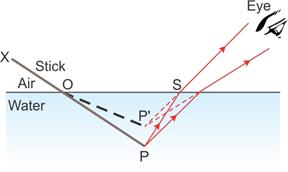
A stick partially immersed in water in a glass container appears bent or raised as shown in figure above. This happens because the rays appear to come from P’ (which is the virtual image of the tip P of the stick) due to refraction from denser medium (water) to rarer medium (air) at the surface separating two media.
Question 6 (Exe-4C and 4D Refraction of light)
A fish is looking at a 1.0 m high plant at the edge of the pond. Will the plant appear shorter or taller than its actual height ? Draw a ray diagram to support your answer.
Answer 6
The plant will look taller than its actual height.

Let the fish is looking from the point O. As the ray OP emerges out from water to air, it will bend away from the normal MN because air is a rarer medium in comparison of water. But if we extend ray OP then it will meet at Q due to which the plant AB will look taller than its actual height.
Page 92
Question 7
A student puts his pencil into an empty trough and observes the pencil from the position indicated in the diagram alongside in Fig. 4.41
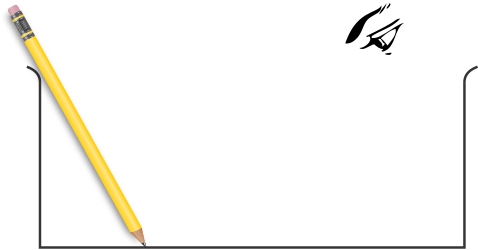
(i) What change will be observed in the appearance of the pencil when water is poured into the trough?
(ii) Name the phenomenon which accounts for the above started observation.
(iii) Complete the diagram showing how the student’s eye sees the pencil through water.
Answer 7
(i)Part of the pencil which is immersed in water will look short and raised up.
(ii)The phenomena which is responsible for the above observation is refraction of light.
(iii)The required figure is

Question 8
An object placed in one medium when seen from the other medium, appears to be vertically shifted. Name the factors on which the magnitude of shift depends and state how does it depend on them.
Answer 8
The factors on which the magnitude of shift depends are:
(a)The refractive index of the medium,
(b)The thickness of the denser medium and
(c)The colour (or wavelength) of incident light.
The shift increase with the increase in the refractive index of medium. It also increases with the increase in thickness of denser medium but the shift decreases with the increases in the wavelength of light used.
“Selina Solution Refraction of Light at Plane Surfaces
Multiple Choice Type 4 (C)
Page 92
Question 1
A small air bubble in a glass block when seen from above appears to be raised because of:
(a) Refraction of light
(b)Reflection of light
(c) Reflection and refraction of light
(d) None of the above
Answer 1
Refraction of light
Hint: When a ray of light travels from denser to rarer medium, it moves away from the normal.
Question 2
An object in a denser medium when viewed from a rarer medium appears to be raised. The shift is maximum for:
(a) Red light
(b) Violet light
(c) Yellow light
(d) Green light
Answer 2
The shift is maximum for violet light.
Hint: The shift is maximum for violet light because the refractive index of glass is the most for the violet light and apparent = (real depth)/(refractive index)
Refraction of Light at Plane Surfaces – Selina Concise ICSE Physics Solutions
Numericals- 4 (C)
Page 92
Question 1
A water pond appears to be 2.7 m deep. If the refractive index of water is 4/3, find the actual depth of the pond.
Answer 1
Apparent depth = 2.7 m
Refractive index of water μw = 4 / 3
Real depth = Apparent depth × μw
Real depth = 2.7 × 4 / 3
Real depth = 3.6 m
Question 2
A coin is placed at the bottom of a beaker containing water (refractive index = 4/3) to a depth of 12 cm. By what height the coin appears to be raised when seen from vertically above?
Answer 2
Refractive index of the water, μw = 4 / 3
Real depth at which coin is placed = 12 cm
Shift in the image = ?
Shift = Real depth × (1 – 1 / μ)
Shift = 12 × (1 – 3 / 4)
Shift = 12 / 4
Shift = 3 cm or R = 3 cm
Question 3 (Exe-4C and 4D Refraction of light)
A postage stamp kept below a rectangular glass block or refractive index 1.5 when viewed from vertically above it, appears to be raised by 7.0 mm. Calculate the thickness of the glass block.
Answer 3
Refractive index of the glass block, μg = 1.5
Shift in the image = 7 mm or 0.7 cm
Thickness of glass block or real depth = ?
Shift = Real depth × (1 – 1 / μ)
0.7 = R × (1 – 1 / 1.5)
R = (0.7 × 1.5) / 0.5
R = 2.1 cm
Refraction of Light at Plane Surfaces – Selina Solution
Exercise 4 (D)
Page 100
Question 1
Explain the term critical angle with the aid of a labelled diagram.
Answer 1
Critical angle: The angle of incidence in the denser medium corresponding to which the angle of refraction in the rarer medium is 90o is called the critical angle.
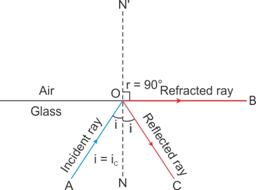
Question 2
How is the critical angle related to the refractive index of a medium?
Answer 2
The critical angle is related to the refractive index of a medium by the relation
![]()
Question 3
State the approximate value of the critical angle for
(a) glass-air surface (b) water-air surface.
Answer 3
(a) The critical angle for glass-air surface is

(b) The critical angle for water-air surface is

Question 4
What is the meant by the statement ‘the critical angle for diamond is 24°?
Answer 4
The critical angle for diamond is 24°. This implies that at an incident angle of 24° within the diamond the angle of refraction in the air will be 90°. And if incident angle will be more than this angle then the ray will suffer total internal reflection without any refraction.
Question 5 (Exe-4C and 4D Refraction of light)
A light ray is incident from a denser medium on the boundary separating it from a rarer medium at an angle of incidence equal to the critical angle. What is the angle of refraction for the ray?
Answer 5
When a ray is incident from a denser medium to a rarer medium at angle equal to critical angle ( ![]() ), the angle of refraction becomes 90°.
), the angle of refraction becomes 90°.
Question 6
Name two factors which affect the critical angle for a given pair of media. State how do the factors affect it.
Answer 6
The factors which affect the critical angle are:
(i)The colour (or wavelength) of light, and
(ii)The temperature
(i)Effect of colour of light: The critical angle for a pair of media is less for the violet light and more for the red light. Thus critical angle increases with increase in wavelength of light.
(ii)Effect of temperature: The critical angle increases with increase in temperature because on increasing the temperature of medium, its refractive index decreases.
Question 7
The critical angle for glass-air is 45° for the light of yellow colour. State whether it will be less than, equal to, or more than 45° for (i) red light, (ii) blue light?
Answer 7
As the wavelength decreases (or increases) refractive index becomes more (or less) and critical angle becomes less (or more).
(i)For red light the critical angle will be more than 45° and
(ii)For blue light the critical angle will be less than 45°.
Question 8
Which colour of light has a higher critical angle? Red light or green light.
Answer 8
The critical angle of red light is higher that of green light.
Question 9
(a)What is total internal reflection?
(b)State two conditions necessary for total internal reflection to occur.
(c)Draw diagrams to illustrate critical angle and total internal reflection.
Answer 9
(a)Total internal reflection: It is the phenomenon when a ray of light travelling in a denser medium, is incident at the surface of a rarer medium such that the angle of incidence is greater than the critical angle for the pair of media, the ray is totally reflected back into the denser medium.
(b)The two necessary conditions for total internal reflection are:
i. The light must travel from a denser medium to a rarer medium.
ii. The angle of incidence must be greater than the critical angle for the pair of media.
(c)When incidence angle is more than critical angle i.e., in case of total internal reflection.
Question 10 (Exe-4C and 4D Refraction of light)
Fill in the blanks to complete the following sentences:
(a)Total internal reflection occurs when a ray of light passes from a ………………..medium to a …………………. medium.
(b)Critical angle is the angle of ……………..in denser medium for which the angle of …………………in rarer medium is ………………
Answer 10
(a)Total internal reflection occurs when a ray of light passes from a denser medium to a rarer medium.
(b)Critical angle is the angle of incidence in denser medium for which the angle of refraction in rarer medium is 90°.
Question 11
State whether the following statement is true or false: If the angle of incidence is greater than the critical angle, light is not refracted at all, when it falls on the surface from a denser medium to a rarer medium.
Answer 11
True
Question 12
The refractive index of air with respect to glass is expressed as ![]()
(a)Write down a similar expression for ![]() in terms of angle .
in terms of angle .
(b)If angle, ![]() what is the corresponding angle i called?
what is the corresponding angle i called?
(c)What is the physical significance of the angle i and part (b)?
Answer 12
(a)
(b)If refractive angle, ![]() , the corresponding angle of incidence, i will be equal to critical angle.
, the corresponding angle of incidence, i will be equal to critical angle.
(c)If the angle of incidenceexceeds the value of i obtained in part (b) (i.e., critical angle), total internal reflection will occur.
Question 13
Fig.4.61 below show two rays A and B travelling from water to air. If the critical angle for water- air surface is 48°, complete the ray diagram showing the refracted rays for each. State conditions when the ray will suffer total internal reflection.
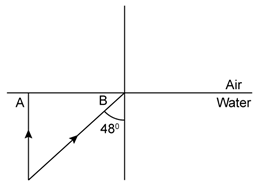
Answer 13
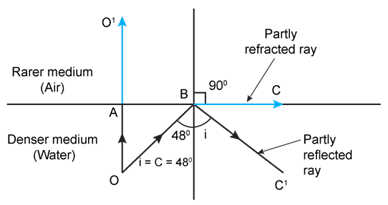
The necessary conditions for the total internal reflection to occur are
(i) Light must travel from a denser medium to a rarer medium.
(ii) The angle of incidence must be greater than the critical angle.
In this case, the angle of incidence.
Page 101
Question 14
Fig. 4.62 shows a point source P inside a water container. Three rays A, B and C starting from the source P are shown up to the water surface.
(a) Show in the diagram, the path of these rays after striking the water surface. The critical angle for water-air surface is 48°.
(b) Name the phenomenon which the rays A, B and C exhibit.
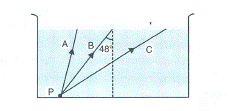
Answer 14
(a)

(b) Rays A and B exhibit the phenomenon of ‘refraction of light’.
Rays C exhibits the phenomenon of ‘total internal reflection’.
Question 15 (Exe-4C and 4D Refraction of light)
In the figure, 4.63 PQ and PR are the two light rays emerging from an object P. The ray PQ is refracted as QS.
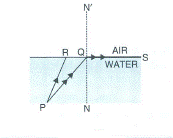
(a) State the special name given to the angle of incidence ![]() PQN of the ray PQ.
PQN of the ray PQ.
(b) What is the angle of refraction for the refracted ray QS?
(c) Name the phenomenon that occurs if the angle of incidence ![]() PQN is increased.
PQN is increased.
(d) The ray PR suffers partial reflection and refraction on the water-air surface. Give reason. Draw in the diagram the refracted ray for the incident ray PR and hence show the position of image of the object P by the letter P’ when seen vertically from above.
Answer 15
(a) Critical angle
Hint: The angle of incidence in the denser medium for which the angle of refraction in rarer medium is 90o is called the critical angle.
(b) 90o
(c) Total internal reflection.
Hint: When the angle of incidence is greater than the critical angle, the phenomenon of total internal reflection occurs due to which the ray of light is not refracted but is reflected back in the same medium.
(d) For the ray PR, the angle of incidence is less than the critical angle (i.e. ); hence, at the interface of two media as per the laws of reflection, ray PR suffers partial reflection and refraction.
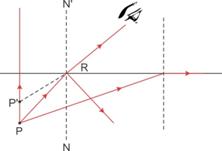
Question 16
The refractive index of glass is 1.5. From a point P inside a glass block, draw rays PA, PB and PC incident on that glass-air surface at an angle of 30o, 42o and 60o respectively.
(a)In the diagram show the approximate direction of these rays as they emerge out of the block.
(b)What is the angle of refraction for the ray PB?
Answer 16
(a)

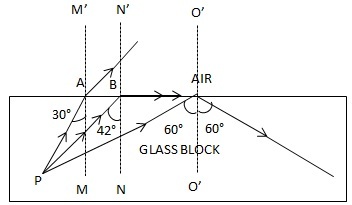
(b)
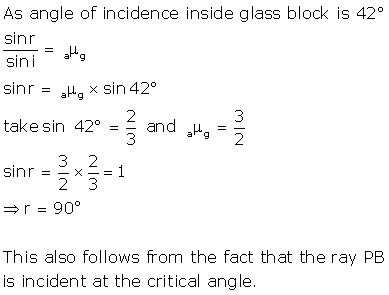
Question 17
A ray of light enters a glass slab ABCD as shown in Fig. and strikes at the Centre O of the circular part AC of the slab. The critical angle of glass is 42°. Complete the path of the ray till it emerges out of the slab. Mark the angles in the diagram wherever necessary.
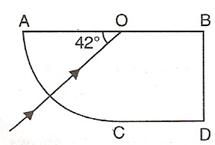
Answer 17
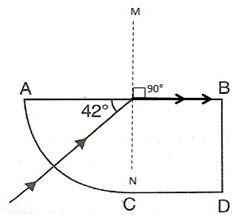
The angle of refraction will be parallel to AB because the ray is incident on the glass at its critical angle.
Question 18
What is a total reflecting prism? State three actions that it can produce. Draw a diagram to show one action of the total reflecting prism.
Answer 18
A prism having an angle of 90° between its two refracting surfaces and the other two angles each equal to 45°, is called a total reflecting prism. The light incident normally on any of its faces, suffers total internal reflection inside the prism.
Due to this behavior, a total reflecting prism is used to produce following three actions:
(a)To deviate a ray of light through 90°,
(b)To deviate a ray of light through 180°, and
(c)To erect the inverted image without producing deviation in its path.
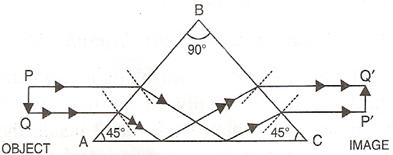
It is an erecting prism which is used to erect the inverted image without producing deviation in its path.
Question 19 (Exe-4C and 4D Refraction of light)
Show with the help of a diagram how a total reflecting prism can be used to turn a ray of light through 90°. Name one instrument in which such a prism is used.
Answer 19
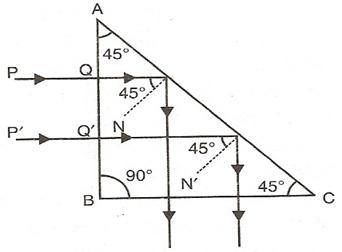
As shown in diagram, a beam of light is incident on face AB of the prism normally so it passes undeviated and strikes the face AC where it makes an angle of 45° with the normal to AC. Because here the incident angle is more than critical angle so rays suffer total internal reflection and reflect at angle of 45°. The beam then strikes face BC, where it is incident normally and so passes undeviated. As a result the incident beam gets deviated through 90°.
Such a prism is used in periscope.
Question 20
A ray of light XY passes through a right angled isosceles prism as shown alongside Figure
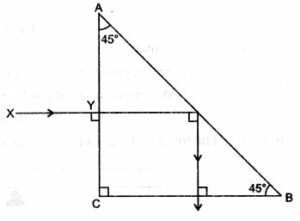
(a) What is the angle through which the incident ray deviates and emerges out of the prism?
(b) Name the instrument Whore this action of the prism is put into use.
(c) Which prism surface will behave as a mirror?
Answer 20
(a) XY = 90°
(b) Periscope
(c) The surface AB of the prism behaves as the mirror
Question 21
Draw a diagram of a right angled isosceles prism which is used to make an inverted image erect.
Answer 21
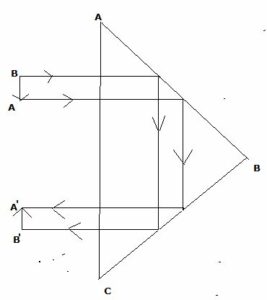
Question 22
In Fig., 4.66 a ray of light PQ is incident normally on the hypotenuse of an isosceles right angle prism ABC.
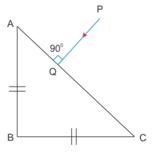
(a) Complete the path of the ray PQ until it emerges from the prism. Mark in the diagram the angle wherever necessary.
(b) What is the angle of deviation of the ray PQ?
(c) Name a device in which this action is used.
Answer 22
(a)
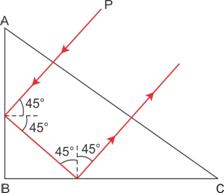
(b) Angle of deviation = 180o
(c) Prism binocular
Page 102
Question 23
In Fig., a ray of light PQ is incident normally on the face AB of an equilateral glass prism. Complete the ray diagram showing its emergence into air after passing through the prism.
Take critical angle for glass = 42°
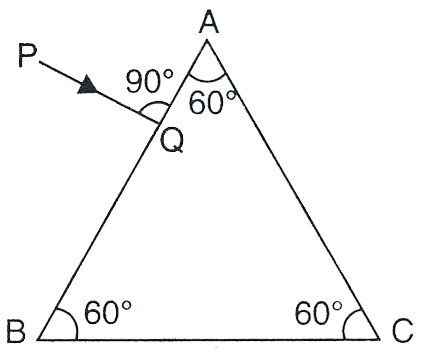
(a)Write the angles of incidence at the faces AB and AC of the prism.
(b)Name the phenomenon which the ray of light suffers at the face AB, AC and BC of the prism.
Answer 23
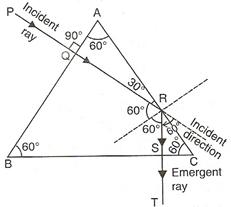
(a)At the face AB,and at the face AC,.
(b)At the face AB – refraction,
and At the face AB – total internal reflection,
while At the face BC – refraction.
Question 24
Copy the diagram given below and complete the path of the light ray till it emerges out of the prism. The critical angle of glass is 42o. In your diagram mark the angles wherever necessary.

Answer 24
Incidence (on the boundary BC) is 60° which is more than its critical angle (42°).
Thus this incident light ray (QR) does not enter into the next medium, instead it undergoes total internal reflection. When this reflected light ray (RS) reaches the side AC, its angle of incidence is 0°.
Again, it does not undergo any refraction, which causes the angle of emergence to become 0°.

Question 25 (Exe-4C and 4D Refraction of light)
Draw a neat labelled ray diagram to show the total internal reflection of a ray of light normally incident on one face of a 30°, 90°,60° prism.
Answer 25
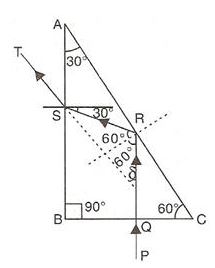
Question 26
What device other than a plane mirror, can be used to turn a ray of light 180°? Draw a diagram in support of your answer. Name an instrument in which in which this device is used.
Answer 26
A total reflecting prism can be used to turn a ray of light by 180°. The following diagram can make it further clear.
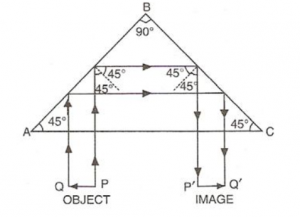
This action of prism is used in binocular.
Question 27
Mention one difference between reflection of light from a plane mirror and total internal reflection of light from a prism.
Answer 27
When total internal reflection occurs from a prism, the entire incident light (100%) is reflected back into the denser medium. Whereas in ordinary reflection from a plane mirror, some light is refracted and absorbed so the reflection is partial.
Question 28
State one advantage of using a total reflecting prism as a reflector in place of a plane mirror.
Answer 28
A total reflecting prism gives us an image much brighter than that obtained by using a plane mirror.
Question 29
Two isosceles right – angled glass prisms are placed near each other as shown in Fig. Complete the path of the light ray entering the first prism till it emerges out of the second prism.
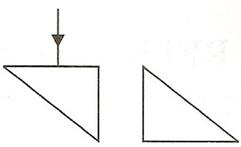
Answer 29
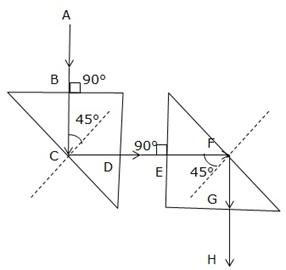
Question 30
Complete the path of ray PQ through the glass prism ABC shown in figure till it emerges out of the prism. Given the critical angle of the glass is 42o.
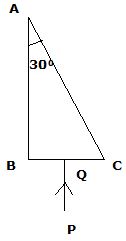
Answer 30
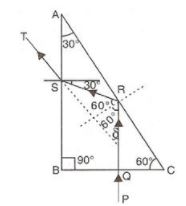
Refraction of Light at Plane Surfaces – Selina ICSE Physics Solution
Multiple Choice Type 4(D)
Page 102
Question 1
The critical angle for glass-air interface is :
(a) 24°
(b) 48°
(c) 42°
(d) 45°
Answer 1
42°
Question 2
A total reflecting right angled isosceles prism can be used to deviate a ray of light through
(a) 30°
(b) 60°
(c) 75°
(d) 90°
Answer 2
90°
Hint:
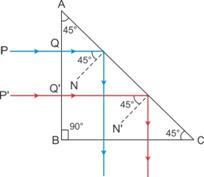
Question 3
A total reflecting equilateral prism can be used to deviate a ray of light through:
(a) 30°
(b) 60°
(c) 75°
(d) 90°
Answer 3
60°
Hint:
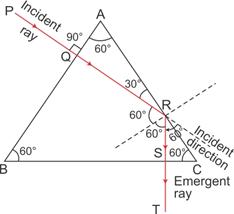
Return to Concise Selina ICSE Physics Class-10
Thanks
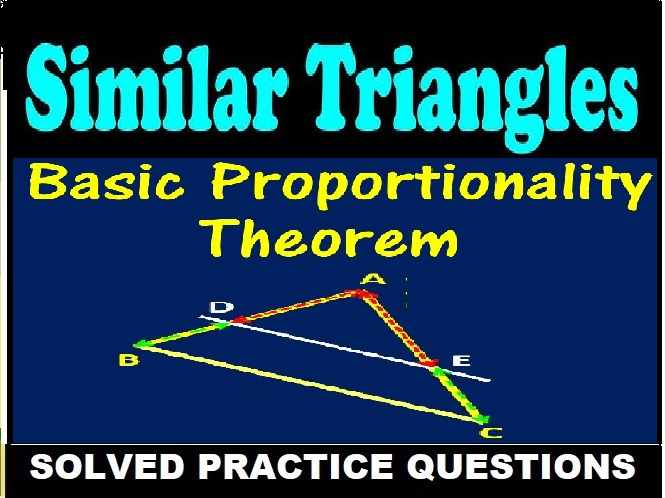
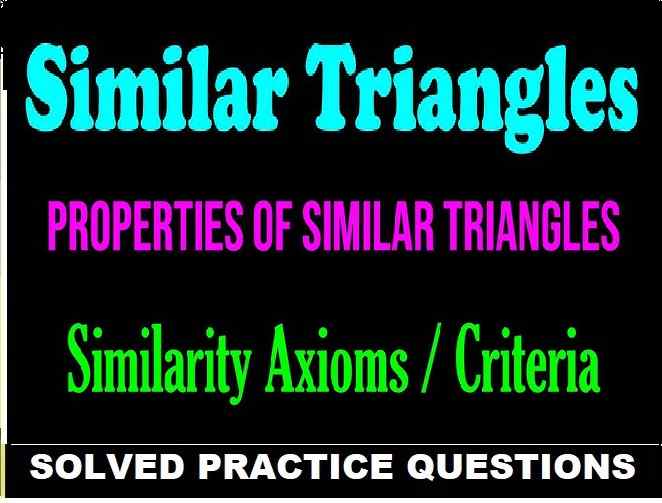
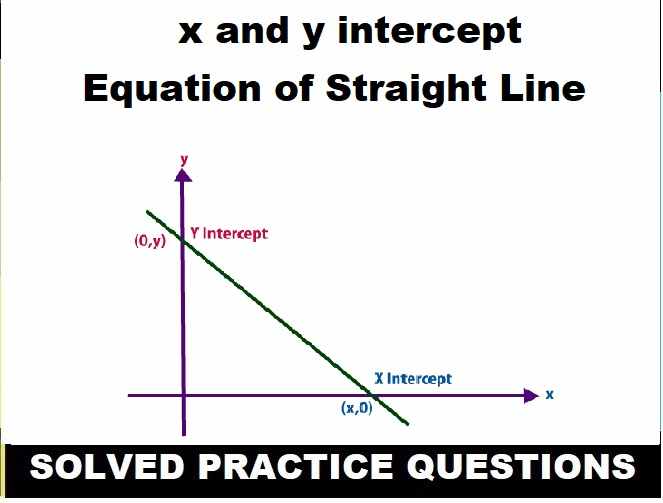
Question 17 Answer is wrong
corrected now